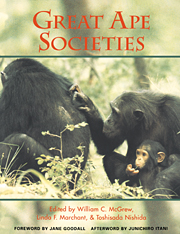Book contents
- Frontmatter
- Contents
- List of contributors
- Preface
- Foreword: conserving great apes
- Part I Apes overviewed
- Part II Social ecology
- Part III Social relations
- Part IV Minds
- Part V Apes compared
- 16 Comparative positional behavior of the African apes
- 17 Nest building behavior in the great apes: the great leap forward?
- 18 Comparative studies of African ape vocal behavior
- 19 On which side of the apes? Ethological study of laterality of hand use
- Part VI Modeling ourselves
- Afterword: a new milestone in great ape research
- Appendix: great ape study sites
- Index
19 - On which side of the apes? Ethological study of laterality of hand use
Published online by Cambridge University Press: 04 August 2010
- Frontmatter
- Contents
- List of contributors
- Preface
- Foreword: conserving great apes
- Part I Apes overviewed
- Part II Social ecology
- Part III Social relations
- Part IV Minds
- Part V Apes compared
- 16 Comparative positional behavior of the African apes
- 17 Nest building behavior in the great apes: the great leap forward?
- 18 Comparative studies of African ape vocal behavior
- 19 On which side of the apes? Ethological study of laterality of hand use
- Part VI Modeling ourselves
- Afterword: a new milestone in great ape research
- Appendix: great ape study sites
- Index
Summary
Of particular interest is the study of Shafer (1987) in which, for the first time in other primates, a significant humanlike pattern consisting of a greater number of animals [i.e. Gorilla gorilla] which preferred the right hand for all acts was observed.
MacNeilage, Studdert-Kennedy & Lindblom, 1991, p. 344Overall, our findings suggest that functional motor asymmetries are present in great apes. A left-hand population preference was found for carrying, while right-hand population preferences were found for object manipulation and leading limbs in locomotion.
Hopkins & Morris, 1993, p. 20INTRODUCTION
Until 1987, the received wisdom in psychobiology was that laterality of function in Homo sapiens was unique, and so qualitatively different from all other species, including even our nearest relations, the great apes. Humans were said to be overwhelmingly right-handed at species (or population) level, that is, about 90% of persons show right-hand dominance for virtually all kinds of hand-use. In contrast, other hominoids were said to be randomly lateralized, either showing no consistent, overall preference for left or right, or being individually lateralized to either the left or right side in about equal numbers.
The published data available on apes at the time seemed to support these views of 50 : 50 randomness, but findings were sparse. Finch's (1941) benchmark study showed a population of 30 chimpanzees in which all but one were lateralized, but to an equal extent for left and right.
- Type
- Chapter
- Information
- Great Ape Societies , pp. 255 - 272Publisher: Cambridge University PressPrint publication year: 1996
- 42
- Cited by



